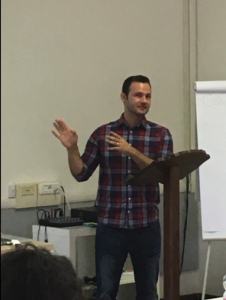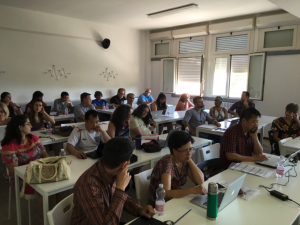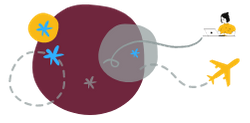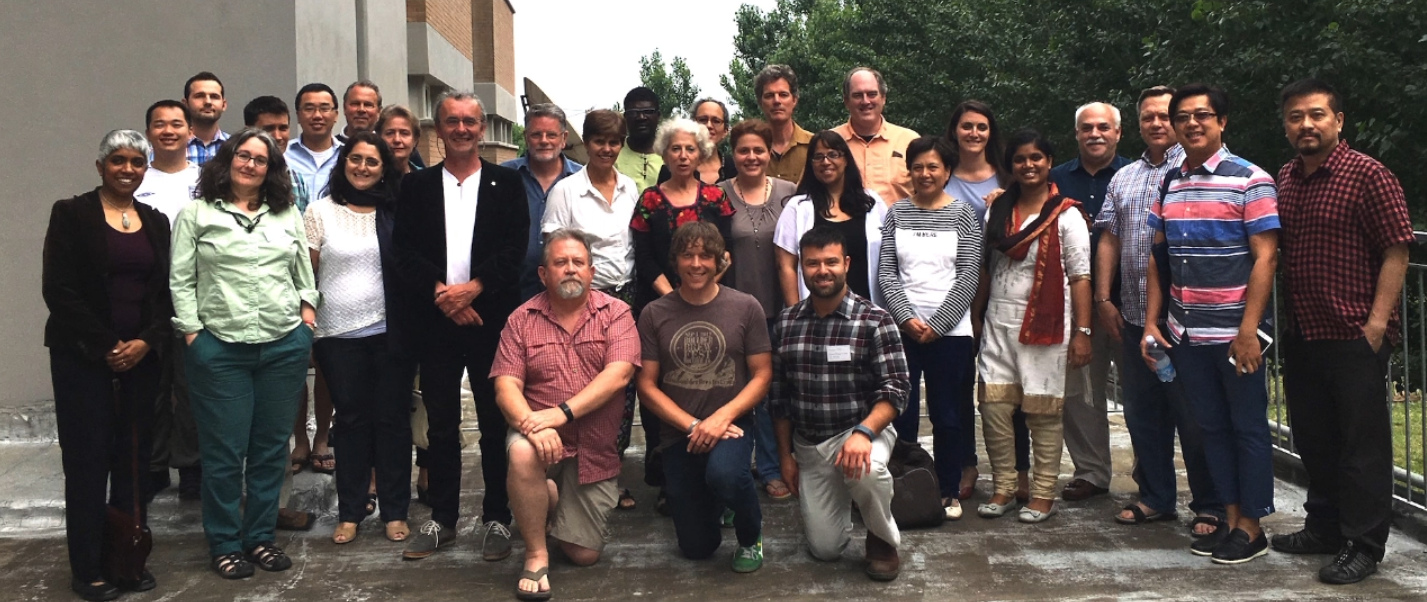Pre-departure:
I am a student studying ancient languages with a focus on Biblical Hebrew and translation, so when my advisor told me about the Nida School of Translation Studies at the San Pellegrino University Foundation in Italy, I was immediately interested. The Nida Institute is the academic arm of the American Bible Society and known for its scholarship in the field of Bible translation in the pioneering tradition of Eugene Nida, perhaps the single most significant figure in the field of translation in the past half century, and a close associate of the South African Greek scholar J. P. Louw. In addition to the prospect of learning about translation from a premier institution specializing in the field, the location being at an Italian university was also very appealing.
The application process required careful planning and documentation. The school is primarily designed for researchers and professionals who have already completed their doctorates. Only a limited number of students currently working on their doctoral program would be admitted. Because of this, I needed to present a compelling curriculum vitae demonstrating my ability to participate in and contribute to the proceedings. Fortunately, I did not need to apply for a visa to Italy and the application for the PGIO travel bursary was pleasantly painless.
I was also required to provide a carefully constructed abstract for my presentation proposal. I decided to do a presentation offering a sample of the doctoral research I have been conducting here at Stellenbosch University in the Ancient Studies Department. My research is focusing on a notoriously difficult to translate particle in Biblical Hebrew that is highly polysemous and ployfunctional with a mysterious and somewhat obscure diachronic history of grammaticalization which has led to the realization of diverse syntactic distribution and syntagmatic compatibility. Needless to say, it’s complicated. I realized that my presentation would need to incorporate enough of my research to be compelling, but not too much so as to make sure I could sufficiently develop a coherent idea in my allotted time, which turned out to be 30 or 35 minutes of presentation followed by about 20 minutes of discussion.
Working on my presentation turned out to be the most time consuming part of my preparation for the school. I decided to write out a full blown paper that could accompany my power point presentation. This accomplished two goals. First, it allowed me to fully flesh out my ideas from my dissertation, yet in a summary paper form. This has turned out to be valuable in helping me think through structuring the rest of my dissertation in my remaining time in the program here at Stellenbosch. It has sort of functioned as a microcosm of my full dissertation. Secondly, this also allowed me to be satisfied with the lesser depth of my power point presentation, since then if anyone who heard my presentation was interested to find out more about the topic, I could then pass along my more fully developed paper. I felt this was a good, best-of-both-worlds compromise that also helped further my PhD research. I am even planning on submitting the more developed paper for publication.

Experience at the Host University:
The location of the host university and the accommodations there were fantastic. The university is located in the Rimini province of Italy on the East coast right on the beach of the Adriatic Sea. Each participant had their own apartment style room at a nearby hotel five minutes walk from the university building with a beachfront view and balcony. All the meals were provided in the hotel restaurant and offered authentic Italian cuisine. Nearby attractions included San Marino, the oldest continuously existing republic in Europe, going back to 300 AD. It is also close to Urbino, a beautiful medieval city and home to the University of Urbino, one of the oldest European universities with several faculty members from the department of linguistics participating in the Nida School of Translation Studies.
Over the course of the program, I had hoped to be introduced to the framework of translation studies. I guess my expectation may have been misinformed in thinking that there is an overarching framework of translation studies, other than perhaps very broadly defining it as interdisciplinarity. If that’s what it is, then I think that came across during my time there. But I hope some more coherent and distinctive pillars will emerge within the discipline. Nevertheless, certainly one of the great benefits of this program is that it brought together one of the most interdisciplinary and ethnically and linguistically diverse groups I’ve ever had the pleasure to be a part of.
The overall program consisted of faculty lectures, associate presentations, round table discussions, and one-on-one tutorials with faculty. I think that the lectures/presentations and tutorials were the most valuable. Especially in the tutorials and other one-on-one conversations, I was able to get closer to digesting and understanding the more foundational issues at play concerning the various topics being presented and how they related to my interests.

One critique I have of the experience (which appears to characterize much of academia these days) is that I felt that the group was not ideologically diverse when it came to a central aspect of translation—the nature of meaning and its relation to translation. I don’t know what past NSTS’s have been like, but think that this year had a strong majority contingency of those who approach epistemology and the idea of meaning from a modernistic or late (post) modernistic perspective. I think it is crucial to include that perspective and I appreciated that. But to be honest, there seemed to be an abrasive attitude toward other perspectives of meaning and epistemology (especially as they relate to sacred texts, in terms of inspiration, inerrancy, authorial intent, canon, etc). This included what seemed to come across sometimes as marginalizing, dismissive, and demeaning comments/interactions in lecture/presentation times, round tables, as well as outside the classroom.
I know that’s not what the NSTS staff intended. But, I do think that is an area for improvement. I think that one way to improve that area would be to consciously facilitate not only geographical, ethnic, linguistic, and disciplinary diversity, but also ideological diversity when it comes to the basic issue of meaning, and how that impacts the issue of sacred text translation. Perhaps this should especially be done in the selection of Nida faculty, as well as taking steps to consciously foster an atmosphere of mutual respect and willingness to engage other perspectives at those fundamental levels.
Return to Stellenbosch:
The return to Stellenbosch was a great time to reflect on my experience and take stock of the ways it contribute to my personal and academic development. One thing that became abundantly clear to me during the trip was that I really do not enjoy long airplane rides and rushed connecting flights all sandwiched between frantic running through train stations and uncomfortable commutes to and from the airport. As fun as it was and as much of a rich experience I had, I was very glad to finally be back home in Stellenbosch.
Nevertheless, my time at the Nida School of Translation studies showed me a truly new and broad world of translation studies that I only had an inkling of in the confines of my studies in linguistics, biblical languages, and the ancient world. I did not realize how many different perspectives and approaches and methodologies can be brought to bear on the task of translation broadly conceived. And, even though I did not find all of the approaches and perspectives compelling enough to adopt in the way I approach translation, it was invaluable to experience a microcosm of all the different types of people from different backgrounds who are participating in this field called translation studies that is becoming so influential.
My experience at this program also showed me the value in attending conferences and workshops where people come together from all over the world to collaborate. The world is a lot bigger than we realize when we do not emerge from our institutional and discipline-specific bubbles to see what other people are doing in our own fields in other parts of the world or in different fields, but in ways that are mutually informative and lend themselves to fruitful collaboration. I now see more than ever the value of these sorts of gatherings for infusing researchers with fresh ideas and expanding our conceptual horizons in ways we would not think of on our own in more isolated settings.
Coming away from this experience has certainly convinced me of the need to be open to, and even consciously pursue, possibilities of interdisciplinary work. I will definitely be seeking to become better informed of trends and advances in translation studies to stay abreast of ways that it can enrich my study of ancient languages and their translation for modern audiences. I will also definitely take the next opportunity I can to travel and become immersed, even if for a short time, in an environment where gifted people gather together in creative and constructive collaboration.

